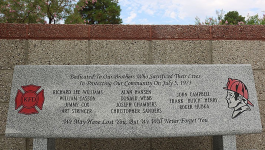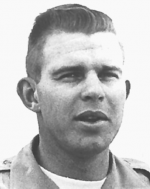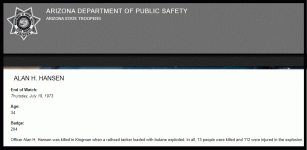Kingman AZ Line of Duty Deaths
July 5, 1973 - Kingman Explosion/Doxol Disaster. 12 Dead. Kingman, AZ
An explosion of a propane railroad tanker car July 5, 1973 in Kingman changed how rail cars are built and affected lives forever. The explosion killed 12 Kingman firefighters and one civilian and injured about 100 others.
With temperatures simmering over 100 degrees, July 5, 1973, became even hotter when a railroad tanker car erupted in a fireball explosion that shook buildings, injured more than 100 people and killed 12 Kingman firefighters and one civilian.
The tanker exploded near the present-day site of a car dealership in the 2600 block of Andy Devine Avenue across from Hoover Street.
Pieces of the tanker car landed near the Louise Avenue railroad crossing about a quarter of a mile away.
No public ceremonies are planned for Saturday, the 30th anniversary of the disaster, but the Kingman Fire Department will have its own remembrance at the moment the call came in on that day when KFD lost a third of its force.
The Kingman firefighters who died were: Christopher Sanders, William Casson, Donald Webb, Frank Henry, Arthur Stringer, Joseph Chambers III, Roger Hubka, Richard Lee Williams, M.B. (Jimmy) Cox and John Campbell.
Alan H. Hansen, a 12-year Arizona Department of Public Safety veteran, was also a volunteer firefighter with KFD who lost his life from burns suffered in the explosion that fateful day less than a quarter mile from DPS's headquarters.
About three dozen Kingman firefighters along with Mohave County sheriff deputies, Kingman police officers and DPS officers responded to the tragedy that literally shook this tiny town of about 7,500 people to its core.
Kingman was a sleepy desert town compared to the mushrooming city of today. Two-lane Stockton Hill Road was not the gridlock corridor it is today. There was no Interstate 40.
Wal-Mart was several decades away and most of the fast food places were only a distant dream. Route 66 was the main east/west artery between California and points eastward.
Around 1:30 on that hot Thursday afternoon, a propane railroad tanker, which sat on a rail siding, was being off-loaded by employees of Doxol Propane into two propane storage tanks. The car was delivered to the spot about a month before that day, according to a 1998 Firehouse magazine article.
Employees had hooked up liquid lines to the fittings when valves were opened slowly to check the connections, KFD Chief Chuck Osterman said.
A leak emitted from one of the connections. One possibility is that a spark from an aluminum wrench, not a normally used non-sparking brass wrench, ignited a fireball that shot up straight into the air.
However it started, the fire disintegrated the walls of the 33,500-gallon tank that was about three quarters full of liquid propane causing the atomic bomb-like eruption approximately 20 minutes later.
Marvin Mast, the manager of Doxol Propane and who was on top of the tanker, died from burns from the initial fire that erupted.
Osterman was a 16-year-old high school student working that summer with a surveying crew near Sitgreaves Pass near Oatman when he saw the smoke over Kingman.
The current fire chief said the explosion was partly responsible for many relatives of those who died that day to choose a career with the fire department.
Osterman's dad was also a volunteer firefighter but was miles away when the tanker exploded. KFD's fire Chief Charlie Potter, who was shielded by his pickup truck, also received serious burns.
Capt. Wayne Davis, a Kingman volunteer firefighter who was also burned, had started as a volunteer just days before the incident. The explosion was only his second emergency call.
Davis was at his family's heating and air conditioning shop when the call came in. A radio station acted as a scanner whenever emergencies occurred. A fire department whistle also shrilled in the downtown area, he said.
Davis, 51, responded to the scene on the back of one of KFD's fire engines. The engine, with Davis standing on the tailboard, was at one point fairly close to the tanker but it left about a minute or two before the explosion.
Davis said his engine had just turned onto Hoover Street from Route 66 to set up hoses at a fire hydrant when the tanker exploded sending a fireball into the air.
"It scared the hell out of me," he said. "I bailed. I jumped off the truck and ran. It was so hot, I couldn't believe the heat."
Liquid propane rained down burning Davis on his hands, arms and face. Just 21, Davis suffered second-degree burns.
Another firefighter on the truck was just four feet away but he was protected from an overhang he was under. He was unhurt.
But others were not so lucky. One firefighter, his clothes nearly burned off, ran past Davis saying, "Wayne, it got us." That firefighter was one of the 11 who died.
Davis said three firefighters died immediately, the rest passed away from their injuries over the next several days.
Most of those who died were trying to set up an unmanned nozzle more than a hundred feet from the tanker to hose down the initial fire when the "boiling liquid expanding vapor explosion" occurred.
The BLEVE (pronounced blevey) was a new word created from Kingman tanker's pressure released explosion.
Three surviving firefighters, two police officers and 95 civilians were burned. Davis said it was so crowded in the emergency room at Kingman Regional Medical Center that the nurses put him in a small closet area. Davis spent about half a day at the hospital but it took several months before he returned to work.
Davis's brother, also a volunteer firefighter, was returning from Lake Havasu City when he stopped for gas in Yucca. When the attendant told him of the explosion, he was able to see the smoke from the gas station.
Davis also said he heard people tell of doors and windows rattling from the explosion as far north as Gordon Drive.
Carroll Brown was the Kingman Police Department chief at the time. He was driving toward the scene along Route 66 from KPD's downtown headquarters when the tanker exploded. The nightmare he witnessed was that of bodies and burning destruction.
"I saw havoc everywhere," he said.
As acting city manager and with Kingman's mayor unavailable, Brown was forced to call National Guard troops to the scene. The sheriff also called every reserve deputy from throughout the county. Even Bullhead City firefighters arrived to help.
Brown said at one point he picked up the microphone in the squad car but no one answered. Only six police officers were on duty, most were injured.
Two of his police officers standing near their patrol cars less than 100 feet away from the tanker were badly burned. What saved them were their vehicles. The vehicles’ windshields and windows melted from the heat, Brown said.
"The worse part of it all was the aftermath," Brown said. "There was funerals almost every day for two weeks. It was an emotional time."
Brown said many of the funerals were held at the high school gymnasium because of the number of mourners.
A railroad conductor to the west of the scene took still pictures of the initial fire and the exploding inferno. A vacationing family was at their motel near Dambar restaurant when they caught the fireball on 8 mm film.
The photos and the film were used in training firefighters for many years afterwards in fighting propane fires, Davis said.
"It changed fire service in fighting this kind of situation," he said.
Because of the Kingman explosion, the Department of Transportation changed the design of propane railroad tankers that carry explosive liquids.
No longer thin, single-wall sheets of steel, rail tankers carrying flammable gasses are now double-walled and protected with insulation that increases the amount of time before a BLEVE occurs.
William L Casson - Age 52
Volunteer fire captain (former fire chief), 27-year veteran fireman, regional manager for Citizens' Utilities Co., a director of the Kingman Chamber of Commerce, and a 31-year member of the Elks.
Myron B. (Jimmy) Cox - Age 55
Assistant fire chief, 22-year veteran fireman, driver for Kingman Bake Shop, a member of the city planning and zoning commission, piano player, and a long-time member of the Elks.
Roger A. Hubka - Age 27
Volunteer fireman, service manager for Double G Tire Co. (one of the companies that was totally destroyed), and a Pop Warner football coach.
Joseph M. Chambers III - Age 37
A 16-year veteran volunteer lieutenant fireman, a member of the Elks, and one of the organizers of Kingman's original Jaycees chapter.
Arthur C. Stringer - Age 25
Vietnam veteran and member of the Arizona national Guard, and a volunteer fireman for one month. His father, also a volunteer fireman, was seriously burned.
Christopher G. Sanders - Age 38
Certified first aid instructor, and executive director of Mohave Big Brothers. He had loaded others into an ambulance before evacuating himself from the scene and helped a newspaper reporter drive the vehicle to the hospital with victims burnt less severely than he was.
Richard Lee Williams - Age 47
Volunteer fireman and principal of the Kingman High School since 1959, coach there 1949-1955, member of the Elks and American Legion and a Rotarian.
Frank S. (Butch) Henry - Age 28
A 7-year volunteer fireman and manager of ICX truck lines.
John O. Campbell - Age 41
Volunteer fireman, head of the Kingman Water Department, assistant city works director. He was also a Little League manager who died on the eve of the opening of a Little League tournament.
Donald G. Webb - Age 38
Volunteer fireman, gas station owner, Elks official and Rotarian.
Alan Hansen - Age 34
Arizona highway patrolman and a fireman, suffered burns over 50 percent of his body trying to help an unconscious fireman.
Marvin E. Mast - Age 42
Manager of Doxol Gas Co., Korean War veteran, and member of a Moose Lodge in Illinois where he lived up to 1972.















